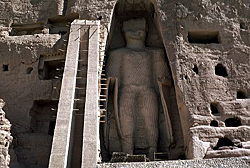 |
|
 |
Inside the Buddha's niche © UNESCO |
 |
Emergency consolidation has been made possible by the project undertaken to safeguard the Bamiyan site and which also allowed for much awaited finds concerning the age of the artefacts. Participants at the Third Experts Working Group Meeting reviewed the activities already undertaken to consolidate the Buddhas’ niches, preserve the statues’ remains, protect the surviving mural paintings from damage, map the site and train local personnel. Despite the great loss caused by the Taleban’s vandalism, the site retains important cultural and artistic remains, notably invaluable mural paintings and the participants at the meeting issued recommendations for the possible continuation of the preservation programme whose first phase, 2002-2004, benefited from international funding, particularly from the provision of US$1,815,967 by the Government of Japan. The meeting notably brought together Norio Suzuki, Director-General Japan’s National Research Institute for Cultural Properties, Tokyo; Haron Amin, Ambassador of Afghanistan to Japan; Ghulam R. Yusufzai, Deputy Minister for Culture, of Afghanistan; Abdul Khaliq Khaleeq, Deputy Governor of Bamiyan; other representatives of the Afghan Ministry of Information and Culture, the International Council on Monuments and Sites (ICOMOS), Japan’s National Research Institute for Cultural Properties and UNESCO’s Division of Cultural Heritage. The project initiated by UNESCO with the Afghan and Japanese authorities followed a mission to the site shortly after the fall of the Taleban. The experts observed that less than 20% of the mural paintings in Bamiyan had survived 22 years of war and that the cliffs and niches that had housed the Buddha statues were showing signs of imminent collapse. Over the past two years, emergency measures have been taken to stave off the collapse, to restrict visitors’ access to the 25 caves containing mural paintings in the Bamiyan, Foladi and Kakrak valleys, all part of the Bamiyan site. With funding from the German government, ICOMOS was able initiate conservation measures to safeguard fragments of the two Buddha statues for future study. ICOMOS was able to use Carbon14 dating technology to ascertain the age of the two Buddha statues: the Small Buddha was shown to be the older of the two, dating from 507 AD while the Great Buddha dates from 551. As in all Carbon14 tests, there is a small margin of error, in these cases of around 15 years. The fragments of the mural paintings that had fallen off the walls of the caves have been collected and the paintings themselves have been documented and recorded. Professor Kosaku Maeda of Wako Universirty (Japan) used Carbon14 technology to date the paintings in all 25 caves, revealing them to have been produced from the 5th to 9th centuries A.D. The German Messerschmitt Foundation provided a large scaffolding free of charge for the emergency consolidation of the cliffs and niches. It was transported to Bamiyan by the German army and the Italian firm RODIO carried out the first phase of emergency consolidation of the two niches of the Buddha statues. The Japanese company PASCO prepared topographical maps and a 3-dimensional relief model of Bamiyan and its surroundings. Japan’s National Research Institute for Cultural Properties carried out archaeological soundings and explorations of the Bamiyan valley and its surroundings to define the areas that need protection from settlement, agriculture and intrusive infrastructure. It provided training to staff of the Afghan Ministry of Information and Culture throughout this work, which has led to the preparation of a Preliminary Master Plan. The participants agreed on the need to pursue the activities undertaken during the first phase of the project, which focused on emergency measures. Longer term measures are still required to ensure the continued preservation of the site. UNESCO’s World Heritage Committee recognized the outstanding universal value of the site and inscribed it, under the name of Cultural landscape and Archaeological Remains of the Bamiyan Valley, on the World Heritage List and on the List of World Heritage in Danger in 2003. The site testifies to the artistic and religious developments of the 1st to 13th centuries, which characterized ancient Bakhtria, integrating various cultural influences into the Gandhara school of Buddhist art. The area contains numerous Buddhist monastic ensembles and sanctuaries, as well as fortified edifices from the Islamic period.
|


